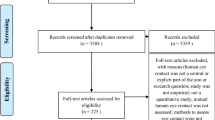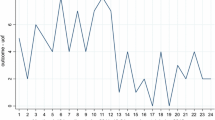Abstract
Eyewitness testimony is a common form of evidence in criminal cases (Wells and Olson Annu Rev Psychol 54:277–295 2003); however, inconsistencies in eyewitness reports are frequent (Brewer and Wells Curr Dir Psychol Sci 20:24–27 2011). This research examined the influence of eyewitness consistency, in combination with relevant case factors, across two experiments. Experiment 1 examined the effect of the number of eyewitness inconsistencies (0, 3, 6 inconsistencies) and eyewitness age (45, 65, 85 years old) on mock juror perceptions and verdict decisions. Similarly, Experiment 2 examined the effect of the number of eyewitness inconsistencies (0, 3, 6 inconsistencies) and crime type (break and enter vs. home invasion with physical assault) on mock juror perceptions and decisions. In both experiments, participants read a mock trial transcript and were asked to render a dichotomous verdict, provide a continuous rating of the defendant’s guilt and rate their perceptions of the defendant and the eyewitness testimonies. Eyewitness inconsistency was found to be influential in both experiments; jurors perceived the eyewitness less positively, perceived the defendant more positively, perceived the defendant as less guilty and rendered less guilty verdicts when the eyewitness was inconsistent in their reports of the crime. Interestingly, there were no effects of eyewitness age or crime type. Implications and directions for future research are discussed.
Similar content being viewed by others
Notes
Each trial transcript was approximately 3000 words.
Each trial transcript was approximately 3000 words.
“Experiment 2” used the same manipulation of eyewitness consistency as was used in “Experiment 1”.
References
Alvarez L, Buckley C (2013) Zimmerman is acquitted in Trayvon Martin killing. The New York Times. https://www.nytimes.com/2013/07/14/us/george-zimmerman-verdict-trayvon-martin.html
Balota DA, Dolan PO, Duchek JM (2000) Memory changes in healthy young and older adults. In: Tulving E, Craik FIM (eds) The Oxford handbook of memory, Oxford University Press, p 395–409
Berman GL, Cutler BL (1996) Effects of inconsistencies in eyewitness testimony on mock-juror decision making. J Appl Psychol 81:170–177. https://doi.org/10.1037/0021-9010.81.2.170
Berman GL, Narby DJ, Cutler BL (1995) Effects of inconsistent eyewitness statements on mock jurors’ evaluations of the eyewitness, perceptions of defendant culpability and verdicts. Law Hum Behav 19:79–88. https://doi.org/10.1037/0021-9010.81.2.170
Bornstein BH, Golding JM, Neuschatz J, Kimbrough C, Reed K, Magyarics C, Luecht K (2017) Mock juror sampling issues in jury simulation research: a meta-analysis. Law Hum Behav 41(1):13–28. https://doi.org/10.1037/lhb0000223
Brewer MB, Dull V, Lui L (1981) Perceptions of the elderly: stereotypes as prototypes. J Pers Soc Psychol 41:656–670. https://doi.org/10.1037//0022-3514.41.4.656
Brewer N, Burke A (2002) Effects of testimonial inconsistencies and eyewitness confidence on mock-juror judgments. Law Hum Behav 26:353–364. https://doi.org/10.1023/A:1015380522722
Brewer N, Hupfeld RM (2006) Effects of testimonial inconsistencies and witness group identity on mock-juror judgements. J Appl Soc Psychol 34:493–513. https://doi.org/10.1111/j.1559-1816.2004.tb02558.x
Brewer N, Potter R, Fisher RP, Bond N, Luszcz MA (1999) Beliefs and data on the relationship between consistency and accuracy of eyewitness testimony. Appl Cogn Psychol 13:297–313. https://doi.org/10.1002/(SICI)1099-0720(199908)13:4%3c297::AID-ACP578%3e3.0.CO;2-S
Brewer N, Wells GL (2011) Eyewitness identification. Curr Dir Psychol Sci 20:24–27. https://doi.org/10.1177/0963721410389169
Brimacombe CAE, Jung S, Garrioch L, Allison M (2003) Perceptions of older adult eyewitnesses: will you believe me when I’m 64? Law Hum Behav 27:507–522. https://doi.org/10.1023/A:1025486006769
Brimacombe CAE, Quinton N, Nance N, Garrioch L (1997) Is age irrelevant? perceptions of young and old adult eyewitnesses. Law Hum Behav 21:619–634. https://doi.org/10.1023/A:1024808730667
Bruer K, Pozzulo J (2012) Influence of eyewitness age and recall error on mock juror decision making. Leg Criminol Psychol 19:332–348. https://doi.org/10.1111/lcrp.12001
Cuddy AJC, Norton MI, Fiske ST (2005) This old stereotype: the pervasiveness and persistence of the elderly stereotype. J Soc Issues 61:267–285. https://doi.org/10.1111/j.15404560.2005.00405.x
Dixon JA, Mahoney B, Cocks R (2002) Accents of guilt? Effects of regional accent, race, and crime type on attributions of guilt. J Lang Soc Psychol 21(2):162–168. https://doi.org/10.1177/02627X02021002004
Dixon JA, Tredoux CG, Durrheim K, Foster DH (1994) The role of speech accommodation and crime type in attribution of guilt. J Soc Psychol 134:465–473. https://doi.org/10.1080/00224545.1994.9712197
Fitzgerald R, Price H (2015) Eyewitness identification across the life span: a meta-analysis of age differences. Psychol Bull 141:1228–1265. https://doi.org/10.1037/bul0000013
Freedman JL, Krismer K, MacDonald JE, Cunningham JA (1994) Severity of penalty, seriousness of the charge, and mock jurors’ verdicts. Law Hum Behav 18:189–202. https://doi.org/10.1007/BF01499015
Frey WH (2010) Baby boomers and the new demographics of America’s seniors. J Am Soc Aging 34(3):28–37
Ghetti S, Redlich AD (2001) Reactions to youth crime: perceptions of accountability and competency. Behav Sci Law 19:33–53. https://doi.org/10.1002/bsl.426
Goodman GS, Golding JM, Helgeson VS, Haith MM, Michelli J (1987) When a child takes the stand: jurors’ perceptions of children’s eyewitness testimony. Law Hum Behav 11:27–40. https://doi.org/10.1007/BF01044837
Kerr N (1978) Severity of prescribed penalty and mock jurors’ verdicts. J Pers Soc Psychol 36:1431–1442
Koriat A, Goldsmith M, Panksy A (2000) Toward a psychology of memory accuracy. Annu Rev Psychol 51:481–537. https://doi.org/10.1146/annurev.psych.51.1.481
Kwong See ST, Hoffman HG, Wood TL (2001) Perceptions of an old female eyewitness: is the older eyewitness believable? Psychol Aging 16:346–350. https://doi.org/10.1037/08827974.16.2.346
Lavis T, Brewer N (2017) Effects of a proven error on evaluations of witness testimony. Law Hum Behav 43:314–323. https://doi.org/10.1037/lhb0000217
Leippe MR, Romanczyk A (1989) Reactions to child (versus adult) eyewitnesses: the influence of jurors’ preconceptions and witness behavior. Law Hum Behav 13:103–132. https://doi.org/10.1007/BF01055919
Lindsay RCL, Lim R, Marando L, Cully D (1986) Mock-juror evaluations of eyewitness testimony: a test of metamemory hypotheses. J Appl Soc Psychol 16:447–459. https://doi.org/10.1111/j.1559-1816.1986.tb01151.x
Mueller-Johnson K, Toglia MP, Sweeney CD, Ceci SJ (2007) The perceived credibility of older adults as witnesses and its relation to ageism. Behav Sci Law 25:355–375. https://doi.org/10.1002/bsl.765
Neal TMS, Christiansen A, Bornstein BH, Robicheaux TR (2012) The effects of mock jurors' beliefs about eyewitness performance on trial judgments. Psychol Crime Law 18(1):49–64. https://doi.org/10.1080/1068316X.2011.587815
O'Neill MC, Pozzulo JD (2012) Jurors' judgments across multiple identifications and descriptions and descriptor inconsistencies. Am J Forensic Psychol 30(2):39–66
Pearson JM, Law JR, Skene JAG, Beskind DH, Vidmar N, Ball DA, Malekpour A, Carter RM, Skene JHP (2018) Modelling the effects of crime type and evidence on judgement about guilt. Nat Hum Behav 2(11):856–866
Pennington N, Hastie R (1986) Evidence evaluation in complex decision-making. J Pers Soc Psychol 51:242–258
Pica E, Sheahan C, Mesesan A, Pozzulo J (2017) The influence of prior familiarity, identification delay, appearance change, and descriptor type and errors on mock jurors’ judgments. J Police Crim Psychol 33:289–301. https://doi.org/10.1007/s11896-017-9251-z
Pica E, Pozzulo J, Sheahan CL, Pratt K (2019) “I know him!”: does witness-defendant familiarity impact mock jurors across differed aged witnesses and types of crime
Pozzulo JD, Dempsey JL (2009) Witness factors and their influence on jurors’ perceptions and verdicts. Crim Justice Behav 36(9):923–934. https://doi.org/10.1177/0093854809338450
Rind B, Jaeger M, Strohmetz DB (1995) Effect of crime seriousness on simulated jurors’ use of inadmissible evidence. J Soc Psychol 135(4):417–424. https://doi.org/10.1080/00224545.1995.9712211
Ross DF, Dunning D, Toglia MP, Ceci SJ (1990) The child in the eyes of the jury. Law Hum Behav 14:5–23. https://doi.org/10.1007/BF01055786
Semmler C, Brewer N (2002) Effects of mood and emotion on juror processing and judgments. Behav Sci Law 20:423–436. https://doi.org/10.1002/bsl.502
Schacter DL (1999) The seven sins of memory: insights from psychology and cognitive neuroscience. Am Psychol 54:182–203. https://doi.org/10.1037/0003-066X.54.3.182
Stanny CJ, Johnson TC (2000) Effects of stress induced by a simulated shooting on recall by police and citizen witnesses. Am J Psychol 113(3):359–386. https://doi.org/10.2307/1423364
Stutzman R, Weiner J (2012) Four witnesses in Trayvon Martin case change their stories. Los Angeles Times. https://www.latimes.com/world/la-xpm-2012-may-25-la-na-zimmerman-witnesses-20120526-story.html
Thompson LE, Sheahan C, Pica E, Pozzulo J (2019) The influence of familiarity recency and eyewitness age on mock jurors’ judgement. J Police Crim Psychol 1–11. https://doi.org/10.1007/s11896-018-9311-z
Walker CM, Woody WD (2011) Juror decision making for juveniles tried as adults: the effects of defendant age, crime type, and crime outcome. Psychol Crim Law 17(8):659–675. https://doi.org/10.1080/10683160903493471
Wells GL, Memon A, Penrod SD (2006) Eyewitness evidence: improving its probative value. Psychol Sci Publ Int 7:45–75. https://doi.org/10.1111/j.1529-1006.2006.00027.x
Wells GL, Olson E (2003) Eyewitness identification. Annu Rev Psychol 54:277–295. https://doi.org/10.1146/annurev.psych.54.101601.145028
Yarmey AD, Kent J (1980) Eyewitness identification by elderly and young adults. Law Hum Behav 4(4):359–371
Author information
Authors and Affiliations
Corresponding author
Ethics declarations
Ethics Approval
All procedures performed in studies involving human participants were in accordance with the ethical standards of the institutional and/or national research committee and with the 1964 Helsinki declaration and its later amendments or comparable ethical standards. This article does not contain any studies with animals performed by any of the authors.
Informed Consent
Informed consent was obtained from all the individual participants included in the study.
Conflict of Interest
The authors declare no competing interests.
Additional information
Publisher's Note
Springer Nature remains neutral with regard to jurisdictional claims in published maps and institutional affiliations.
Rights and permissions
About this article
Cite this article
Fraser, B.M., Mackovichova, S., Thompson, L.E. et al. The Influence of Inconsistency in Eyewitness Reports, Eyewitness Age and Crime Type on Mock Juror Decision-Making. J Police Crim Psych 37, 351–364 (2022). https://doi.org/10.1007/s11896-021-09464-9
Accepted:
Published:
Issue Date:
DOI: https://doi.org/10.1007/s11896-021-09464-9




